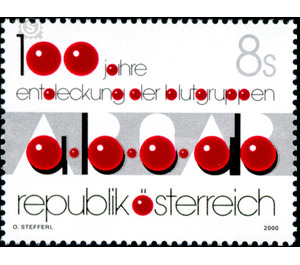100 years - Austria / II. Republic of Austria 2000 - 8 Shilling
Theme: Health & Human
| Country | Austria / II. Republic of Austria |
| Issue Date | 2000 |
| Face Value | 8.00 |
| Printing Type | Photogravure |
| Stamp Type | Commemorative |
| Item Type | Stamp |
| Chronological Issue Number | 1665 |
| Chronological Chapter | OOS-OE2 |
| SID | 146355 |
| In 57 Wishlists | |
On March 23, 1901, Karl Landsteiner published his 17th work entitled "On Agglutination Symptoms of Normal Human Blood". He had already mentioned in a scientific paper published in 1900 the supposition that the interaction of human blood samples could be a natural trait. He had studied the mutual reactions between red blood cells and blood sera and found that normally in human sera are antibodies that agglutinate the blood cells of other people. He suspected that it could be an individual property of the blood. Landsteiner had thus discovered various types of blood. With his discovery, he laid the foundation for modern, responsible transfusion practice. In 1930 he received the Nobel Prize for the discovery of human blood groups and their role in blood transfusion. Together with Alexander Wiener, he discovered the Rhesus Factor in 1940. Today, more than 75 blood group systems and more than 500 factors are known.


